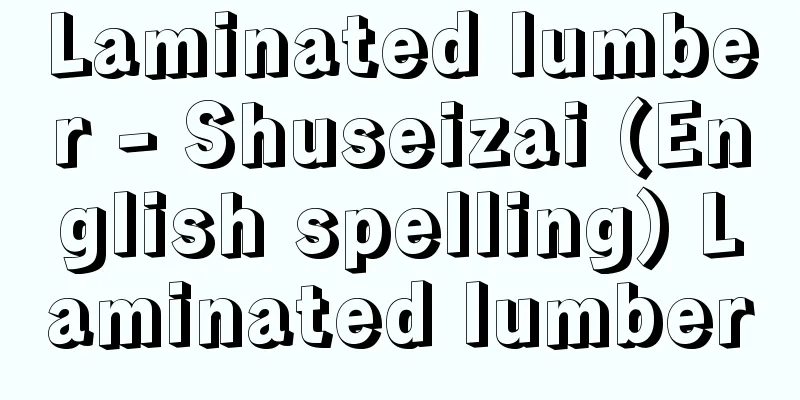Laminated lumber - Shuseizai (English spelling) Laminated lumber

|
Laminated lumber is made by drying sawn boards (laminar), aligning the fibers in a parallel direction, and gluing them together in the length, width, and thickness directions. Its main features are that defects in the wood, such as large knots and cracks, are dispersed or removed, and there is little warping caused by unevenness in the wood, or cracking or warping during drying. Therefore, it is stronger than sawn lumber and is more stable when used. In addition, long and large lumber can be made from small diameter lumber or leftover lumber, and the cross-sectional dimensions can be determined rationally based on design conditions. Curved shapes can also be manufactured, and it combines decorative and structural functions, and is often used in gymnasiums and restaurants. The manufacturing standards for laminated lumber are determined by the Japanese Agricultural Standards (JAS), and are broadly divided into those for construction and those for structure, and further classified into those for decorative purposes, which are made by covering the surface with thin boards of natural wood grain to give them a beautiful appearance, and those for other purposes. In particular, interior construction materials such as pillars, nageshi, and kamoi are unique to Japan. In other countries, laminated timber is used primarily for structural purposes, and because of its large cross-section and high fire safety, there are buildings made of laminated timber called heavy timber construction. [Arima Takashi] Source: Shogakukan Encyclopedia Nipponica About Encyclopedia Nipponica Information | Legend |
|
製材した板(ラミナーlaminar)を乾燥し、繊維方向を平行にして、長さ、幅、厚さ方向に集成接着した材。そのおもな特長は、大きな節や割れのような木材の欠点を分散または取り除き、木材の不均一性からくる狂いや乾燥時の割れや反(そ)りが少ない点にある。したがって、製材品より強く、使用時の安定性も高い。また、小径材や残材から長大材ができ、断面寸法などを設計条件から合理的に決められる。形状が湾曲したものも製造可能であり、化粧と構造とを兼ね備え、体育館やレストランなどに使用される例も多い。集成材の製造基準は日本農林規格(JAS(ジャス))で決められているが、造作用と構造用に大きく区分され、さらに表面に天然木目の薄板を張って美観を与えた化粧張りと、そうでないものとに分類されている。とくに柱や長押(なげし)、鴨居(かもい)など内装造作材は日本特有のものである。諸外国では構造用が主体で、その断面が大きく、防火上の安全性が高いことからheavy timber construction(重木構造)とよばれる集成材構造の建築物がある。 [有馬孝] 出典 小学館 日本大百科全書(ニッポニカ)日本大百科全書(ニッポニカ)について 情報 | 凡例 |
<<: Revisionism (English spelling) German
Recommend
Silence in Ichiharano - Silence in Ichiharano
...Kinpira Joruri, a famous old Joruri, features ...
Departmental Ministers
… In the United Kingdom, known as the birthplace ...
Takasato [Village] - Takasato
A village in Yama District, northwest of Fukushima...
Hagi Clan Clan Records
A collection of genealogies and ancient documents...
Okumumeo - Okumumeo
Social activist. Born in Fukui Prefecture. Real n...
Flower Friendship Association
...In the Meiji period, after Rien, there was a t...
Sakurama Banma
Noh actor. Shite actor of the Konparu school. In ...
Ohara disease - Oharabyo
Tularemia Yato Hospital Another name for this con...
Atash Kadeh - Atash Kadeh
… There are about 50 known Zoroastrian fire templ...
Parasitic volcano
A volcano that is formed like a lump by an erupti...
Scoliidae
…General term for insects belonging to the family...
avatara (English spelling)
…This Garuda is said to eat a snake (dragon) to t...
Nikko
[1] [noun] sunlight. ray of sunlight. ※Suga-ke Bun...
Standard scale - hyojunjyaku (English spelling) standard scale
They are more accurate than metal rulers and are u...
Akizaki Fukujusou - Akizaki Fukujusou
... Adonis vernalis L. (English name: Spring adon...









